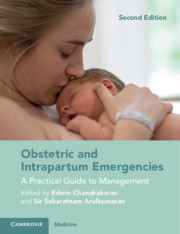Description
Obstetric and Intrapartum Emergencies (2nd Ed., Revised edition)
A Practical Guide to Management
Coordinators: Chandraharan Edwin, Arulkumaran Sir Sabaratnam
Language: English
Subject for Obstetric and Intrapartum Emergencies:
Publication date: 06-2021
350 p. · 19x24.6 cm · Paperback
350 p. · 19x24.6 cm · Paperback
Description
/li>Contents
/li>Biography
/li>
Global and national confidential inquiry reports show that 60 to 80% of maternal and neonatal morbidity and mortality are due to avoidable errors. This comprehensive and illustrated second edition offers a practical guide to the management of obstetric, medical, surgical, anaesthetic and newborn emergencies in addition to organisational and training issues. The book is divided conveniently into nine sections and updated throughout in line with modern research and practice. Several new chapters cover setting up skills and drills training in maternity services to reduce avoidable harm, managing obstetric emergencies during 'home births' and in low-risk midwifery units, and minimizing maternal and fetal morbidity in failed operative vaginal delivery. Each chapter includes a practical algorithm for quick reference, the scientific basis for proposed actions, a case-based practical exercise and useful learning tools such as 'Key Pearls' and 'Key Pitfalls'. An invaluable resource for obstetricians, neonatologists, midwives, medical students, anesthesiologists and the wider perinatal team.
Part I. General Principles: 1. Anatomical and physiological changes during pregnancy: impact on emergency care; 2. Principles of resuscitation for 'maternal collapse' during pregnancy, labour and postpartum: airway, breathing and circulation; Part II. Algorithms for Management of the Top Five 'Direct Killers': 3. Management of deep-vein thrombosis and pulmonary embolism: antepartum, intrapartum and postpartum; 4. Management of severe pre-eclampsia and eclampsia: antepartum, intrapartum nd postpartum; 5. Management of massive obstetric haemorrhage: antepartum, intrapartum and postpartum; 6. Management of septicaemia and septic shock: antepartum, intrapartum and postpartum; 7. Management of amniotic fluid embolism; Part III. Intrapartum Emergencies: 8. Uterine rupture; 9. Breech delivery; 10. Umbilical cord prolapse; 11. Fetal compromise: diagnosis and management; 12. Shoulder dystocia; 13. Twin delivery; 14. Instrumental vaginal delivery; 15. 'Crash' emergency caesarean section; 16. Unintended trauma and complications during caesarean section; 17. Managing obstetric emergencies during 'home births' and in low-risk midwifery units; Part IV. Postpartum Emergencies: 18. Acute puerperal uterine inversion; 19. Sudden postpartum maternal collapse; 20. Retained placenta; 21. Perineal trauma during delivery; Part V. Medical and Surgical Emergencies during Pregnancy: 22. Palpatations in pregnancy; 23. Breathlessness in pregnancy; 24. Abdominal pain in pregnancy; 25. Blurring of vision and sudden loss of vision in pregnancy; 26. Psychiatric emergencies in pregnancy; 27. Drug overdose in pregnancy; 28. Diabetic ketoacidosis in pregnancy; 29. Convulsions and epilepsy in pregnancy; 30. Musculoskeletal considerations in pregnancy; 31. Endocrine emergencies in pregnancy; Part VI. Anaesthetic Emergencies during Pregnancy: 32. General anesthesia and failed intubation in pregnancy; 33. Fluid underload and overload and the management of cardiac emergencies in pregnancy; 34. Transfusion and anaphylactic and adverse drug reactions in pregnancy; 35. Major trauma, including road traffic accidents, in pregnancy; Part VII. Neonatal Emergencies and the Management of Immediate Neonatal Problems: 36. Neonatal resuscitation and the management of immediate neonatal problems; Part VIII. Management of Anticipated and Non-Anticipated Emergencies in Pregnancy: 37. Placenta acreta Spectrum (PAS) disorders; 38. Peri- and postmortem caesearean section; 39. Preterm labour and rescue cerclage; 40. Failed operative vaginal delivery: minimizing maternal and fetal morbidity; Part IX. Setting-Up Skills and Drills Training in Maternity Services and Reducing Avoidable Harm: 41. Addressing human factors in obstetric emergencies; 42. Setting up and running labor ward fire drills; 43. Simulation training for obstetric emergencies; 44. Learning from mbrrace and each baby counts; 45. Risk-management for emergency obstetric and intrapartum care.
Edwin Chandraharan is the Director of Global Academy of Medical Education and Training Ltd.
Sir Sabaratnam Arulkumaran is Professor of Obstetrics and Gynaecology and Chair of Obstetrics and Gynaecology at the University of Nicosia Medical School. He is also Professor Emeritus of Obstetrics and Gynaecology at St George's, University of London, and Visiting Professor at the Institute of Global Health Innovation, at Imperial College Foundation, London.
Sir Sabaratnam Arulkumaran is Professor of Obstetrics and Gynaecology and Chair of Obstetrics and Gynaecology at the University of Nicosia Medical School. He is also Professor Emeritus of Obstetrics and Gynaecology at St George's, University of London, and Visiting Professor at the Institute of Global Health Innovation, at Imperial College Foundation, London.
© 2024 LAVOISIER S.A.S.




